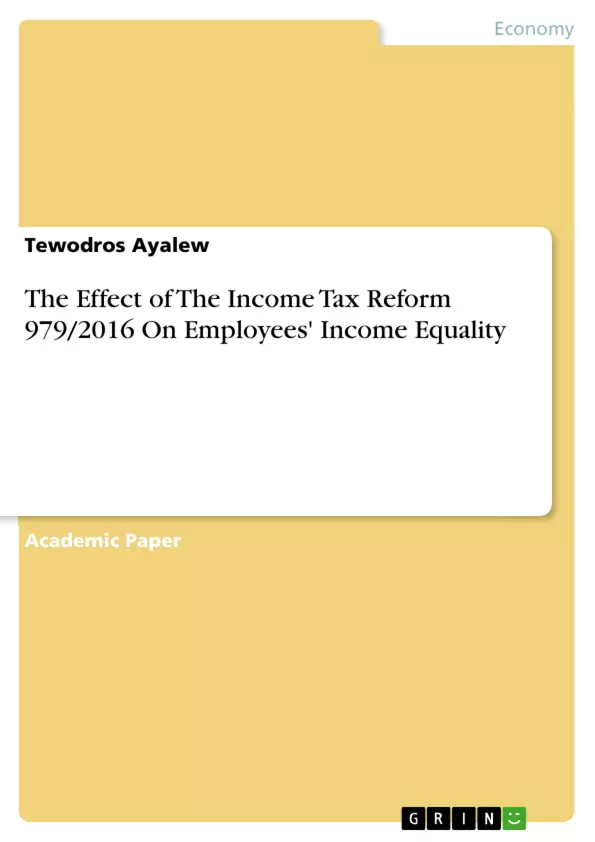This research investigates the effect of the new income tax Proclamation 979/2016 on the employee’s disposable income, tax liability and the income inequalities among the high and low income earning groups of employees. For this, the quantitative research method is used and secondary payroll data is collected through the survey by using email and hard copy.
The data is analyzed using the summary of descriptive statistics and paired sample means t-Test. Besides this, Gini-coefficient analytical tool is also used to measure the income inequalities among 1120 employees. The payroll data is gathered from 8 different public and private companies in Addis Ababa. The sample is selected by applying purposive sampling techniques and the sample size is determined using a statistical formula for an unknown population.
The result shows that the tax reform brings a 9% increases on a disposable income and 30% decreases on the income tax liability of employees under this investigation. But on the contrary, the new tax reform doesn't play its role in reducing the income inequality among different income earning groups of employees rather it shows 0.4% marginal increases in income inequalities.
This is because of reform gives higher disposable income for the top 20% income earning groups than the lower one. Furthermore, the study evidences the existence of high-income inequality among employees which is 0.41 Gini coefficient. It is slightly higher than the national Gini coefficient it is because of the size and scope of the study.
Finally, the research indicates that 73% of the income tax revenue has paid by the top 20% income earning groups. So, it is advisable for policymakers to improve the minimum taxable income from birr 601 to birr1500 to reduce the income inequality by minimizing the tax burden of lower income earning groups.
Inhaltsverzeichnis (Table of Contents)
- Introduction
- Background of the Study
- Statement of the Problem
- Research Questions
- The Objective of This Paper
- Objectives (General)
- Specific Objectives
- Scope of the Study
- The Significance of the Study
- Organization of the Paper
- Limitation of the Research
- The Theoretical and empirical Literature Review
- Definition and Classification of Taxes
- Theories of Taxation
- The Haig-Simons Income Tax Theory
- Samuelson Depreciation
- Lorenz Curve, Gini Coefficient
- Empirical Literature Review
- The Research's Empirical Contribution to other Similar Studies
- Literature Gap and Summary
- Conceptual Framework of the Study
- Research Design and Method
- Research Design
- Sample and Sampling Techniques
- Source and Tools/Instruments of Data Collection
- Method of Data Analysis
- Data Analysis and Interpretation
- General Information about Data
- Descriptive Statistical Data Analysis and Interpretation
- The paired sample means t-test
- Analysis of Income Inequality among different income groups
Zielsetzung und Themenschwerpunkte (Objectives and Key Themes)
This research aims to investigate the effects of the new income tax reform 979/2016 on employees' disposable income, income tax liability, and income inequality reduction in Addis Ababa, Ethiopia. The study focuses on employees from both public and private companies.
- The impact of the new income tax reform on employees' disposable income
- The impact of the new income tax reform on employees' income tax liability
- The impact of the new income tax reform on income inequality reduction
- The effectiveness of the new income tax reform in achieving its stated objectives
- The implications of the new income tax reform for the Ethiopian economy
Zusammenfassung der Kapitel (Chapter Summaries)
The introduction of the research sets the stage by outlining the background, problem statement, research questions, objectives, scope, significance, organization, and limitations of the study. The literature review delves into the theoretical and empirical foundations of taxation, examining concepts like the Haig-Simons Income Tax Theory, Samuelson Depreciation, Lorenz Curve, and Gini Coefficient. It also provides a thorough review of existing empirical studies and highlights the research's unique contribution. The research design and methodology chapter outlines the study's approach, sample selection, data collection methods, and data analysis techniques. The analysis and interpretation of the data explore the general information about the data, descriptive statistics, and paired sample means t-test to evaluate the impact of the income tax reform. The study also examines income inequality among different income groups.
Schlüsselwörter (Keywords)
The study revolves around key concepts like income tax reform, disposable income, income tax liability, income inequality, Ethiopia, Addis Ababa, public and private companies, empirical research, paired sample means t-test, Lorenz Curve, and Gini Coefficient.
- Citation du texte
- Tewodros Ayalew (Auteur), 2019, The Effect of The Income Tax Reform 979/2016 On Employees' Income Equality, Munich, GRIN Verlag, https://www.grin.com/document/497409



